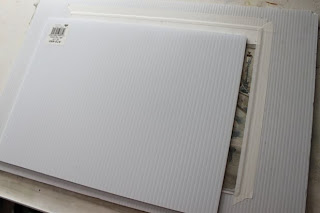 This post addresses two questions I hear often--whether it is necessary to pre-stretch the paper for a watercolor painting, and how to flatten a painting that is buckled or warped.
This post addresses two questions I hear often--whether it is necessary to pre-stretch the paper for a watercolor painting, and how to flatten a painting that is buckled or warped.I don't stretch the paper before painting. One reason is that I have very limited time for painting, and this preparatory step would consume some of that time. Secondly, I often paint outdoors, and it would be impractical to carry several boards with stretched paper. Finally, I don't really find it necessary.
As the photo above illustrates, I simply clip the sheet corners to the board and that works well for my purposes.
While clipping the sheet to the board keeps the paper flat while I'm painting, sometimes the sheet warps after I take the clips off, and I need to flatten it. I'll use my latest painting to illustrate the process, as in the photo below.

1. First, I wet the back of the painting thoroughly with a flat brush and clean water. I spread the water evenly on the entire surface.

2. As show in the photo, I allow the paper to absorb the water evenly until saturated, and add more water in some spots if I notice they are drying too rapidly (I live in Colorado and the air is very dry).

3. I wait until dampness is down to a sheen, and turn the paper over, to be face up, onto a clean, dry board. I place another board over the painting and press it down to make sure it's flat.

4.I move the board to expose one edge of the sheet at a time, and tape that edge down with masking tape. I press and flatten the tape well to avoid any gaps or bubles. I repeat until all edges are taped.

5.I remove the board from the top and let the painting dry, laying horizontally, face up, uncovered, until it's completely dry and stretched. This could take many hours, so I often leave it to dry overnight.

6.Finally, I remove the tape carefully to avoid tearing or damage to the paper, and the painting is now completely flat.






